Deep-Learning Based Prognosis Approach for Remaining Useful Life Prediction of Turbofan Engine
Abstract
:1. Introduction
2. Related Works
2.1. RUL Prediction Based on Physical Models
2.2. RUL Prediction Based on Data-Driven Models
3. The Proposed Approach
3.1. C-MAPSS Benchmark Dataset
3.2. Feature Selection Using the Prognosability Algorithm
3.3. Data Normalization
3.4. Deep Convolutional Neural Networks
3.4.1. Convolutional Layer
3.4.2. Pooling Layer
3.4.3. Fully Connected Layer
3.5. Proposed Attention Mechanism
3.6. Time Window Technique
4. Experimental Results and Discussion
4.1. Experimental Results
4.2. Case Study of Turbofan Engine System
4.3. Comparison with Literature
5. Conclusions
Author Contributions
Funding
Institutional Review Board Statement
Informed Consent Statement
Data Availability Statement
Conflicts of Interest
References
- Chen, X.; Wang, S.; Qiao, B.; Chen, Q. Basic research on machinery fault diagnostics: Past, present, and future trends. Front. Mech. Eng. 2018, 13, 264–291. [Google Scholar] [CrossRef] [Green Version]
- Peng, C.; Chen, Y.; Chen, Q.; Tang, Z.; Li, L.; Gui, W. A Remaining Useful Life Prognosis of Turbofan Engine Using Temporal and Spatial Feature Fusion. Sensors 2021, 21, 418. [Google Scholar] [CrossRef] [PubMed]
- Wang, L.; Zhang, Z.; Long, H.; Xu, J.; Liu, R. Wind turbine gearbox failure identification with deep neural networks. IEEE Trans. Ind. Inform. 2016, 13, 1360–1368. [Google Scholar] [CrossRef]
- Zhao, G.S.; Wu, S.S.; Rong, H.J. A Multi-Source Statistics Data-Driven Method for Remaining Useful Life Prediction of Aircraft Engine. J. Xi’an Jiaotong Univ. 2017, 51, 150–155. [Google Scholar]
- Zhang, Z.; Si, X.; Hu, C.; Lei, Y. Degradation data analysis and remaining useful life estimation: A review on Wiener-process-based methods. Eur. J. Oper. Res. 2018, 271, 775–796. [Google Scholar] [CrossRef]
- Zschech, P.; Bernien, J.; Heinrich, K. Towards a Taxonomic Benchmarking Framework for Predictive Maintenance: The Case of NASA’s Turbofan Degradation. In Proceedings of the Fortieth International Conference on Information Systems (ICIS 2019), Munich, Germany, 15–18 December 2018; 2018; pp. 1–15. [Google Scholar]
- Muneer, A.; Taib, S.M.; Fati, S.M.; Balogun, A.O.; Aziz, I.A. A Hybrid Deep Learning-Based Unsupervised Anomaly Detection in High Dimensional Data. Comput. Mater. Contin. 2021, 71. [Google Scholar] [CrossRef]
- Wei, J.; Bai, P.; Qin, D.; Lim, T.C.; Yang, P.; Zhang, H. Study on vibration characteristics of fan shaft of geared turbofan engine with sudden imbalance caused by blade off. J. Vib. Acoust. 2018, 140, 041010. [Google Scholar] [CrossRef]
- Si, X.S.; Wang, W.; Hu, C.H.; Zhou, D.H. Remaining useful life estimation–a review on the statistical data driven approaches. Eur. J. Oper. Res. 2011, 213, 1–14. [Google Scholar] [CrossRef]
- Ahmadzadeh, F.; Lundberg, J. Remaining useful life estimation. Int. J. Syst. Assur. Eng. Manag. 2014, 5, 461–474. [Google Scholar] [CrossRef]
- Xie, Z.; Du, S.; Lv, J.; Deng, Y.; Jia, S. A hybrid prognostics deep learning model for remaining useful life prediction. Electronics 2021, 10, 39. [Google Scholar] [CrossRef]
- Wen, L.; Dong, Y.; Gao, L. A new ensemble residual convolutional neural network for remaining useful life estimation. Math. Biosci. Eng 2019, 16, 862–880. [Google Scholar] [CrossRef]
- Babu, G.S.; Zhao, P.; Li, X.L. Deep convolutional neural network-based regression approach for estimation of remaining useful life. In Proceedings of the International Conference on Database Systems for Advanced Applications, Dallas, TX, USA, 16–19 April 2016; Springer: Cham, Switzerland, 2016; pp. 214–228. [Google Scholar]
- Li, X.; Ding, Q.; Sun, J.Q. Remaining useful life estimation in prognostics using deep convolution neural networks. Reliab. Eng. Syst. Saf. 2018, 172, 1–11. [Google Scholar] [CrossRef] [Green Version]
- Hinchi, A.Z.; Tkiouat, M. Rolling element bearing remaining useful life estimation based on a convolutional long-short-term memory network. Procedia Comput. Sci. 2018, 127, 123–132. [Google Scholar] [CrossRef]
- Agrawal, S.; Sarkar, S.; Srivastava, G.; Maddikunta, P.K.R.; Gadekallu, T.R. Genetically optimized prediction of remaining useful life. Sustain. Comput. Inform. Syst. 2021, 31, 100565. [Google Scholar]
- da Costa, P.R.D.O.; Akcay, A.; Zhang, Y.; Kaymak, U. Attention and long short-term memory network for remaining useful lifetime predictions of turbofan engine degradation. Int. J. Progn. Health Manag. 2019, 10, 034. [Google Scholar]
- Ghorbani, S.; Salahshoor, K. Estimating Remaining Useful Life of Turbofan Engine Using Data-Level Fusion and Feature-Level Fusion. J. Fail. Anal. Prev. 2020, 20, 323–332. [Google Scholar] [CrossRef]
- Sun, H.; Guo, Y.; Zhao, W. Fault detection for aircraft turbofan engine using a modified moving window KPCA. IEEE Access 2020, 8, 166541–166552. [Google Scholar] [CrossRef]
- Elasha, F.; Shanbr, S.; Li, X.; Mba, D. Prognosis of a wind turbine gearbox bearing using supervised machine learning. Sensors 2019, 19, 3092. [Google Scholar] [CrossRef] [Green Version]
- Hong, S.; Zhou, Z.; Zio, E.; Hong, K. Condition assessment for the performance degradation of bearing based on a combinatorial feature extraction method. Digit. Signal. Process. 2014, 27, 159–166. [Google Scholar] [CrossRef]
- Yang, B.; Liu, R.; Zio, E. Remaining useful life prediction based on a double-convolutional neural network architecture. IEEE Trans. Ind. Electron. 2019, 66, 9521–9530. [Google Scholar] [CrossRef]
- Ren, L.; Sun, Y.; Wang, H.; Zhang, L. Prediction of bearing remaining useful life with deep convolution neural network. IEEE Access 2018, 6, 13041–13049. [Google Scholar] [CrossRef]
- Alzubaidi, L.; Zhang, J.; Humaidi, A.J.; Al-Dujaili, A.; Duan, Y.; Al-Shamma, O.; Santamaría, J.; Fadhel, M.A.; Al-Amidie, M.; Farhan, L. Review of deep learning: Concepts, CNN architectures, challenges, applications, future directions. J. Big Data 2021, 8, 1–74. [Google Scholar] [CrossRef] [PubMed]
- Hou, G.; Xu, S.; Zhou, N.; Yang, L.; Fu, Q. Remaining useful life estimation using deep convolutional generative adversarial networks based on an autoencoder scheme. Comput. Intell. Neurosci. 2020, 2020, 1–14. [Google Scholar] [CrossRef] [PubMed]
- Chen, Z.; Wu, M.; Zhao, R.; Guretno, F.; Yan, R.; Li, X. Machine remaining useful life prediction via an attention-based deep learning approach. IEEE Trans. Ind. Electron. 2020, 68, 2521–2531. [Google Scholar] [CrossRef]
- Song, F.; Ai, Z.; Zhang, H.; You, I.; Li, S. Smart Collaborative Balancing for Dependable Network Components in Cyber-Physical Systems. IEEE Trans. Ind. Inform. 2020, 17, 6916–6924. [Google Scholar] [CrossRef]
- Hoeppner, D.W.; Krupp, W.E. Prediction of component life by application of fatigue crack growth knowledge. Eng. Fract. Mech. 1974, 6, 47–70. [Google Scholar] [CrossRef]
- Jiang, Y.Y.; Zeng, W.W.; Shen, J.J.; Chu, J. Prediction of remaining useful life of lithium-ion battery based on convex optimization life parameter degradation mechanism model. Proc. CSU EPSA 2019, 31, 23–28. [Google Scholar]
- Gao, T.; Li, Y.; Huang, X.; Wang, C. Data-Driven Method for Predicting Remaining Useful Life of Bearing Based on Bayesian Theory. Sensors 2021, 21, 182. [Google Scholar] [CrossRef] [PubMed]
- Le Son, K.; Fouladirad, M.; Barros, A.; Levrat, E.; Iung, B. Remaining useful life estimation based on stochastic deterioration models: A comparative study. Reliab. Eng. Syst. Saf. 2013, 112, 165–175. [Google Scholar] [CrossRef]
- Strušnik, D.; Brandl, D.; Schober, H.; Ferčec, J.; Avsec, J. A simulation model of the application of the solar STAF panel heat transfer and noise reduction with and without a transparent plate: A renewable energy review. Renew. Sustain. Energy Rev. 2020, 134, 110149. [Google Scholar] [CrossRef]
- Yuan, M.; Wu, Y.; Lin, L. Fault diagnosis and remaining useful life estimation of aero engine using LSTM neural network. In Proceedings of the 2016 IEEE International Conference on Aircraft Utility Systems (AUS), Beijing, China, 10–12 October 2016; IEEE: Piscataway, NJ, USA, 2016; pp. 135–140. [Google Scholar]
- Zhao, R.; Wang, J.; Yan, R.; Mao, K. Machine health monitoring with LSTM networks. In Proceedings of the 2016 10th International Conference on Sensing Technology (ICST), Beijing, China, 10–12 October 2016; IEEE: Piscataway, NJ, USA, 2016; pp. 1–6. [Google Scholar]
- Liao, L.; Jin, W.; Pavel, R. Enhanced restricted Boltzmann machine with prognosability regularization for prognostics and health assessment. IEEE Trans. Ind. Electron. 2016, 63, 7076–7083. [Google Scholar] [CrossRef]
- Zhang, C.; Lim, P.; Qin, A.K.; Tan, K.C. Multiobjective deep belief networks ensemble for remaining useful life estimation in prognostics. IEEE Trans. Neural Netw. Learn. Syst. 2016, 28, 2306–2318. [Google Scholar] [CrossRef] [PubMed]
- Zheng, S.; Ristovski, K.; Farahat, A.; Gupta, C. Long short-term memory network for remaining useful life estimation. In Proceedings of the 2017 IEEE International Conference on Prognostics and Health Management (ICPHM), Dallas, TX, USA, 19–21 June 2017; IEEE: Piscataway, NJ, USA, 2017; pp. 88–95. [Google Scholar]
- Zhu, J.; Chen, N.; Peng, W. Estimation of bearing remaining useful life based on multiscale convolutional neural network. IEEE Trans. Ind. Electron. 2018, 66, 3208–3216. [Google Scholar] [CrossRef]
- Zhang, X.; Xiao, P.; Yang, Y.; Cheng, Y.; Chen, B.; Gao, D.; Liu, W.; Huang, Z. Remaining useful life estimation using CNN-XGB with extended time window. IEEE Access 2019, 7, 154386–154397. [Google Scholar] [CrossRef]
- Frederick, D.; de Castro, J.; Litt, J. User’s Guide for the Commercial Modular Aero-Propulsion System Simulation (C-MAPSS); NASA/ARL: Hanover, MD, USA, 2007. [Google Scholar]
- Xiang, S.; Qin, Y.; Luo, J.; Pu, H.; Tang, B. Multicellular LSTM-based deep learning model for aero-engine remaining useful life prediction. Reliab. Eng. Syst. Saf. 2021, 216, 107927. [Google Scholar] [CrossRef]
- Duan, Y.; Li, H.; He, M.; Zhao, D. A BiGRU Autoencoder Remaining Useful Life Prediction Scheme With Attention Mechanism and Skip Connection. IEEE Sens. J. 2021, 21, 10905–10914. [Google Scholar] [CrossRef]
- Heimes, F.O. Recurrent neural networks for remaining useful life estimation. In Proceedings of the 2008 International Conference on Prognostics and Health Management, Denver, CO, USA, 6–9 October 2008; IEEE: Piscataway, NJ, USA, 2008; pp. 1–6. [Google Scholar]
- Durairajah, V.; Gobee, S.; Muneer, A. Automatic vision based classification system using DNN and SVM classifiers. In Proceedings of the 2018 3rd International Conference on Control, Robotics and Cybernetics (CRC), Penang, Malaysia, 26–28 September 2018; IEEE: Piscataway, NJ, USA, 2018; pp. 6–14. [Google Scholar]
- Choi, J.Y.; Lee, B. Ensemble of deep convolutional neural networks with Gabor face representations for face recognition. IEEE Trans. Image Process. 2019, 29, 3270–3281. [Google Scholar] [CrossRef] [PubMed]
- Akbar, N.A.; Darmayanti, I.; Fati, S.M.; Muneer, A. Deep Learning of a Pre-trained Language Model’s Joke Classifier Using GPT-2. J. Hunan Univ. Nat. Sci. 2021, 48. [Google Scholar]
- Muneer, A.; Fati, S.M.; Fuddah, S. Smart health monitoring system using IoT based smart fitness mirror. Telkomnika. 2020, 18, 317–331. [Google Scholar] [CrossRef]
- Muneer, A.; Fati, S.M. Efficient and Automated Herbs Classification Approach Based on Shape and Texture Features using Deep Learning. IEEE Access 2020, 8, 196747–196764. [Google Scholar] [CrossRef]
- Naseer, S.; Ali, R.F.; Muneer, A.; Fati, S.M. IAmideV-deep: Valine amidation site prediction in proteins using deep learning and pseudo amino acid compositions. Symmetry 2021, 13, 560. [Google Scholar] [CrossRef]
- Naseer, S.; Ali, R.F.; Fati, S.M.; Muneer, A. iNitroY-Deep: Computational Identification of Nitrotyrosine Sites to Supplement Carcinogenesis Studies Using Deep Learning. IEEE Access 2021, 9, 73624–73640. [Google Scholar] [CrossRef]
- Yamashita, R.; Nishio, M.; Do, R.K.G.; Togashi, K. Convolutional neural networks: An overview and application in radiology. Insights Into Imaging 2018, 9, 611–629. [Google Scholar] [CrossRef] [PubMed] [Green Version]
- Naseer, S.; Saleem, Y. Enhanced Network Intrusion Detection using Deep Convolutional Neural Networks. TIIS 2018, 12, 5159–5178. [Google Scholar]
- Kingma, D.P.; Ba, J. Adam: A method for stochastic optimization. arXiv 2014, arXiv:1412.6980. [Google Scholar]
- Saxena, A.; Goebel, K.; Simon, D.; Eklund, N. Damage propagation modeling for aircraft engine run-to-failure simulation. In Proceedings of the 2008 International Conference on Prognostics and Health Management, Denver, CO, USA, 6–9 October 2008; IEEE: Piscataway, NJ, USA, 2008; pp. 1–9. [Google Scholar]
- Peng, Y.; Wang, H.; Wang, J.; Liu, D.; Peng, X. A modified echo state network based remaining useful life estimation approach. In Proceedings of the 2012 IEEE Conference on Prognostics and Health Management, Denver, CO, USA, 18–21 June 2012; IEEE: Piscataway, NJ, USA, 2012; pp. 1–7. [Google Scholar]
- Laredo, D.; Chen, Z.; Schütze, O.; Sun, J.Q. A neural network-evolutionary computational framework for remaining useful life estimation of mechanical systems. Neural Netw. 2019, 116, 178–187. [Google Scholar] [CrossRef] [PubMed] [Green Version]
- Aggarwal, K.; Atan, O.; Farahat, A.K.; Zhang, C.; Ristovski, K.; Gupta, C. Two birds with one network: Unifying failure event prediction and time-to-failure modeling. In Proceedings of the 2018 IEEE International Conference on Big Data (Big Data), Seattle, WA, USA, 10–13 December 2018; IEEE: Piscataway, NJ, USA, 2018; pp. 1308–1317. [Google Scholar]
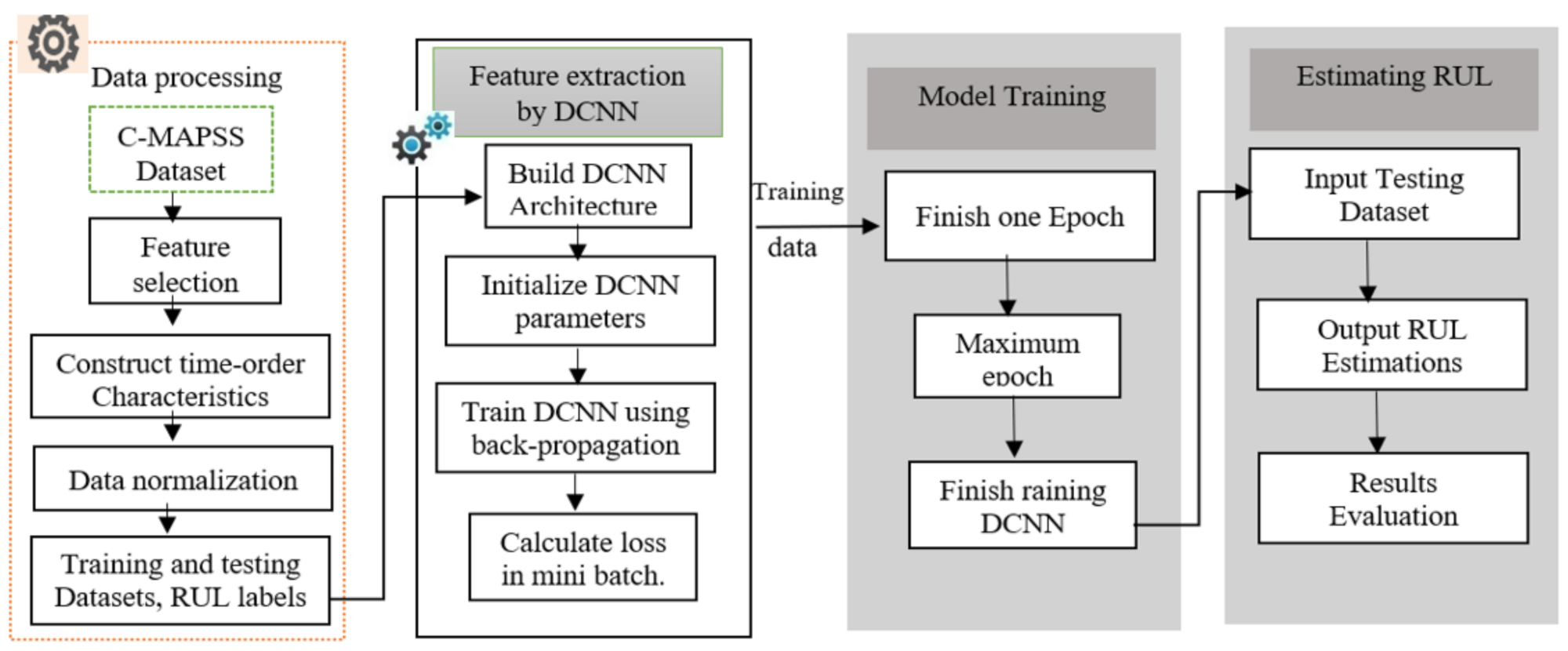

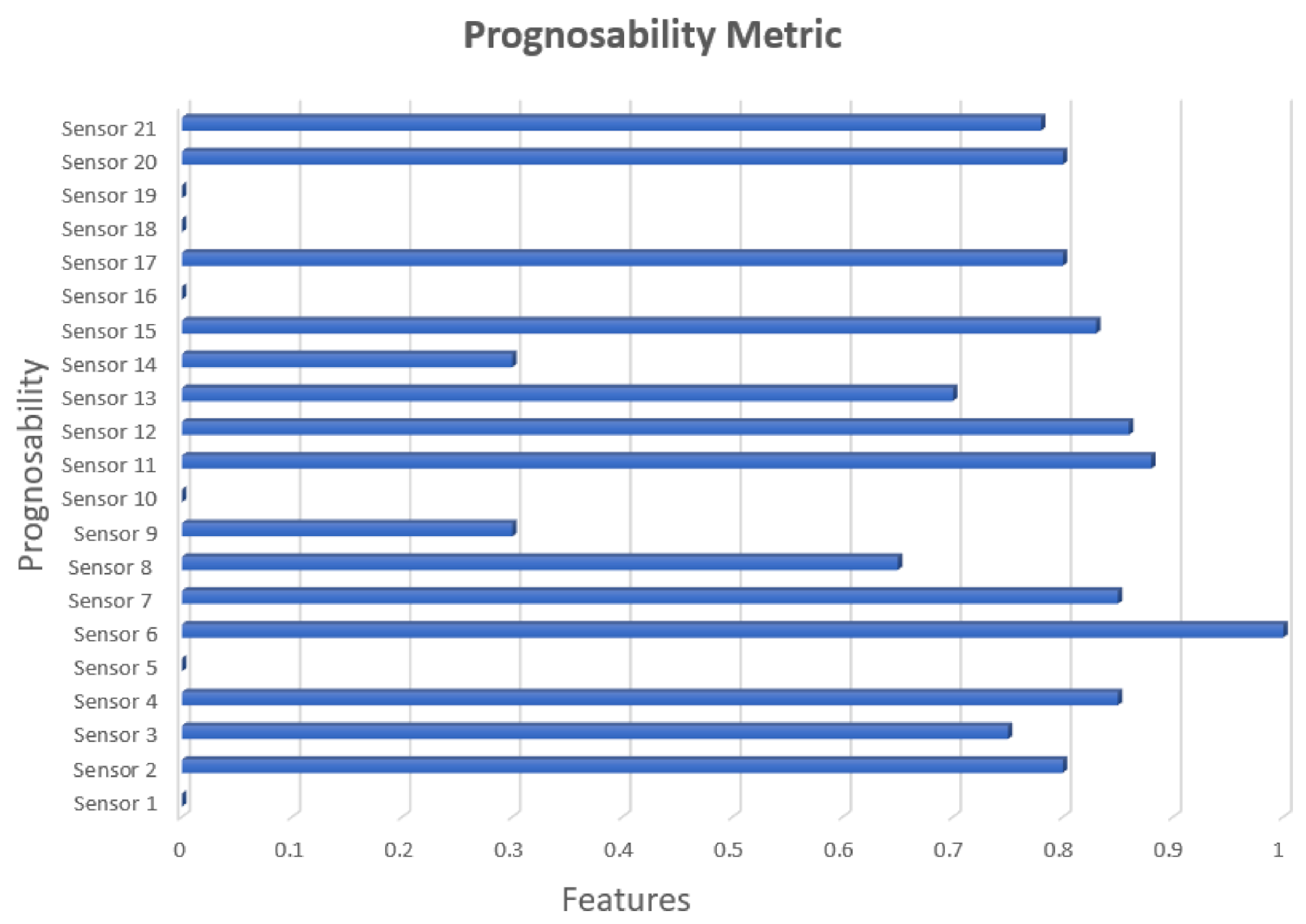
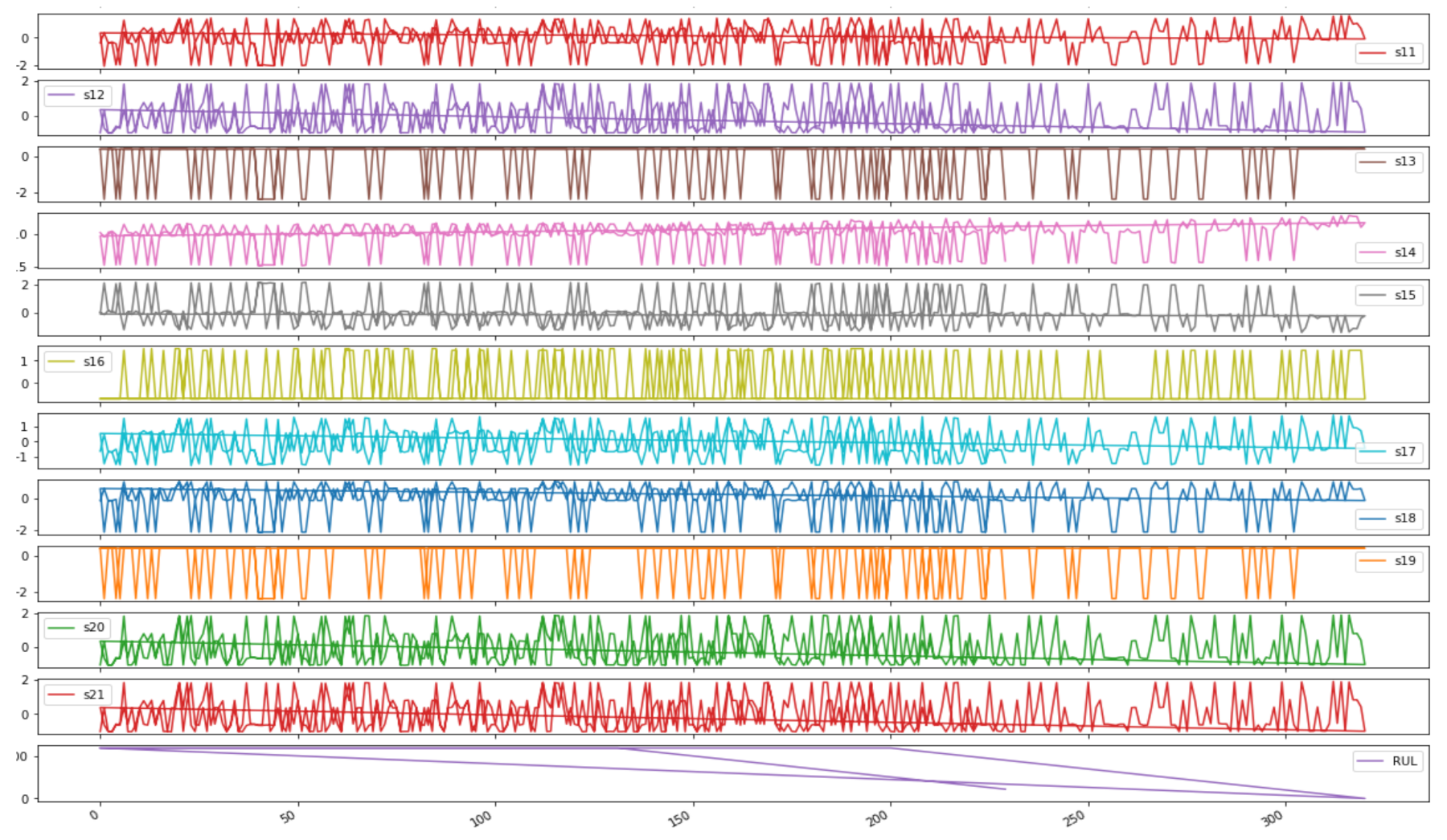

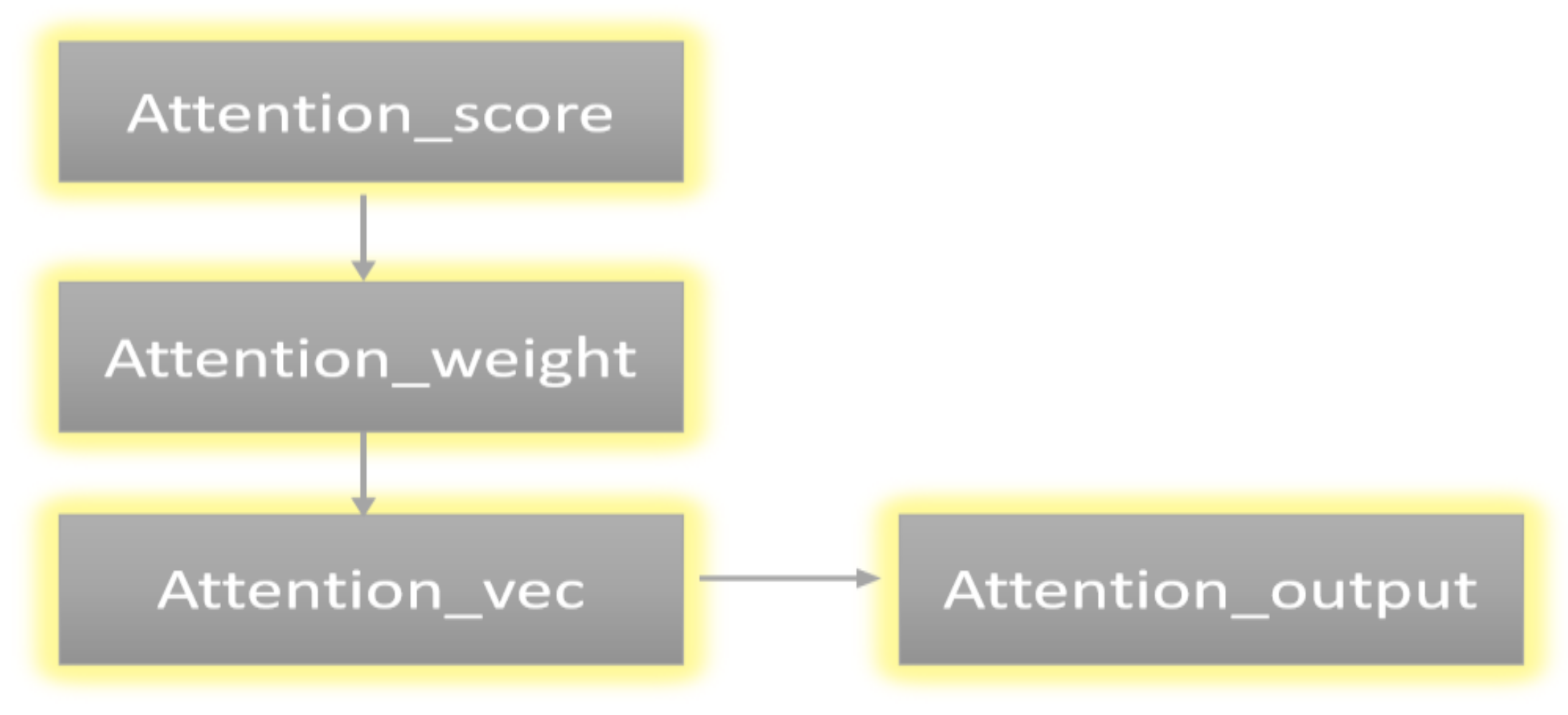
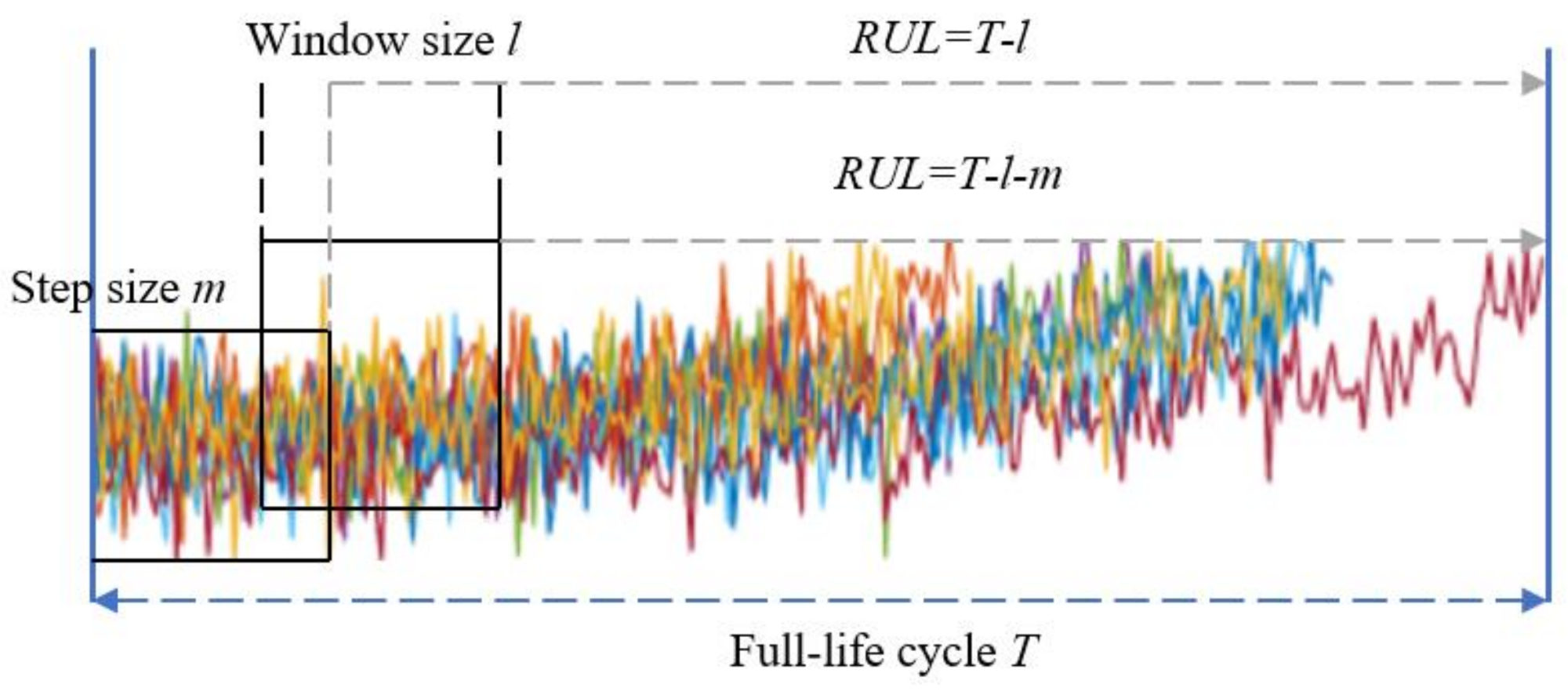
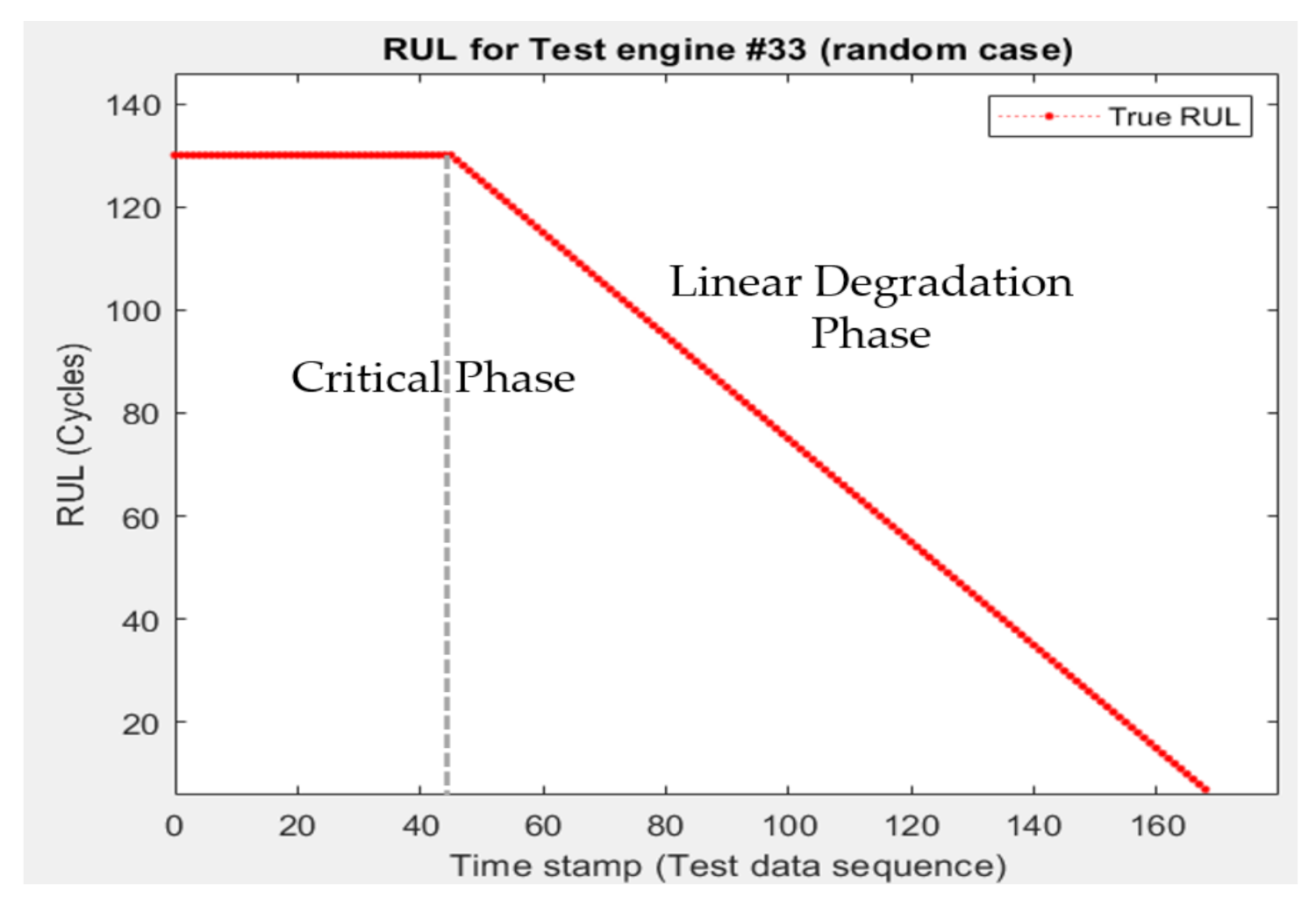
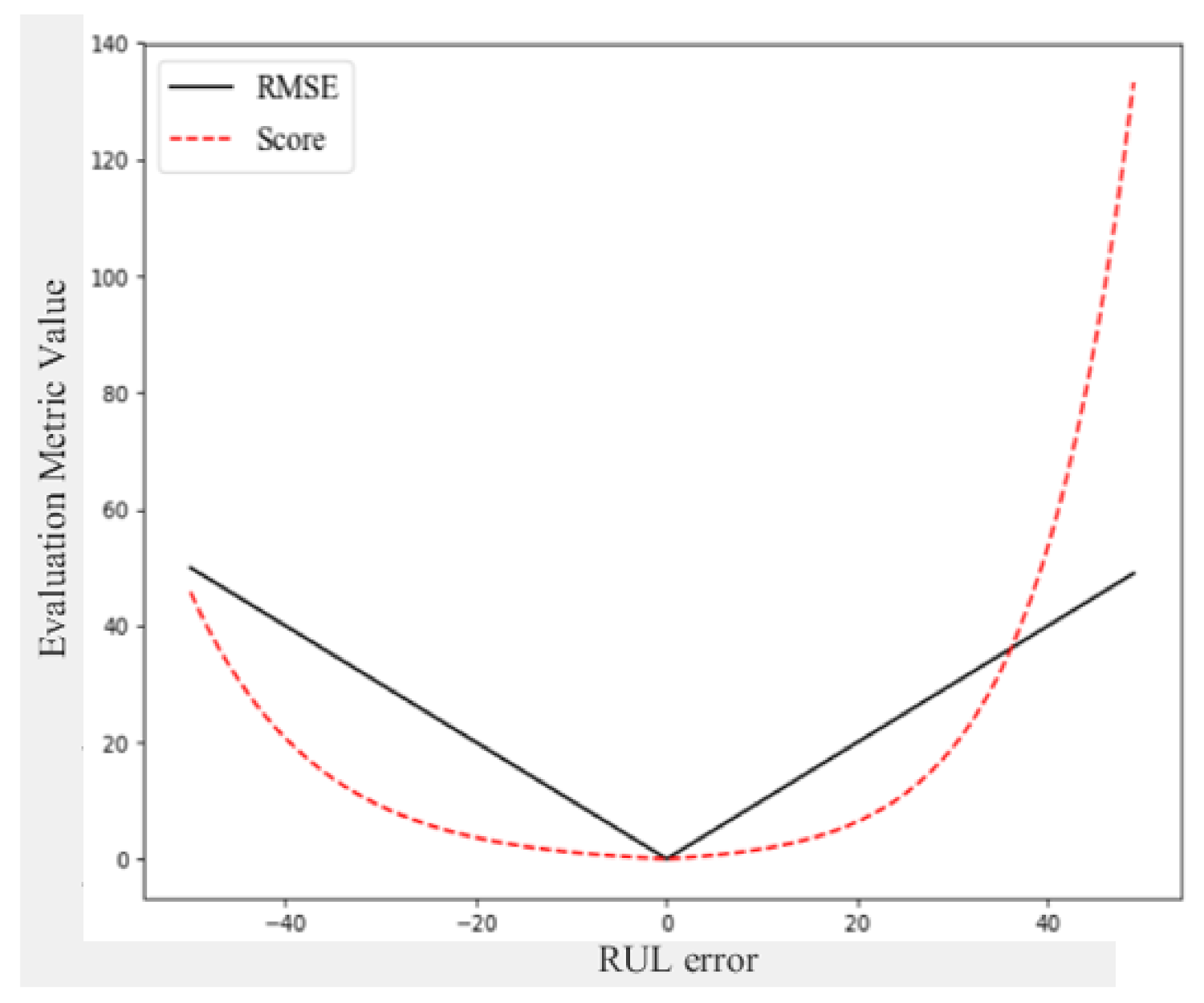
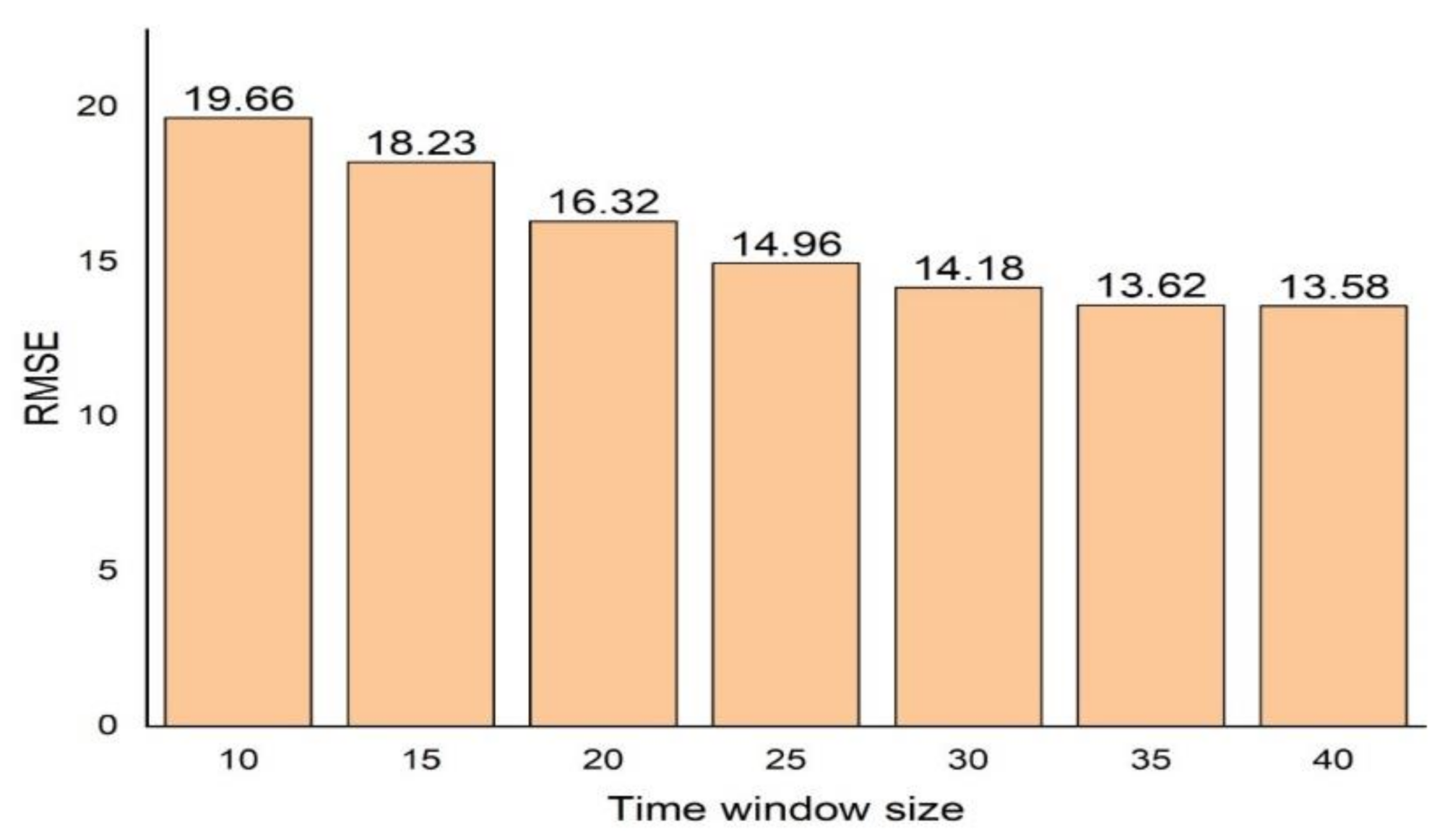

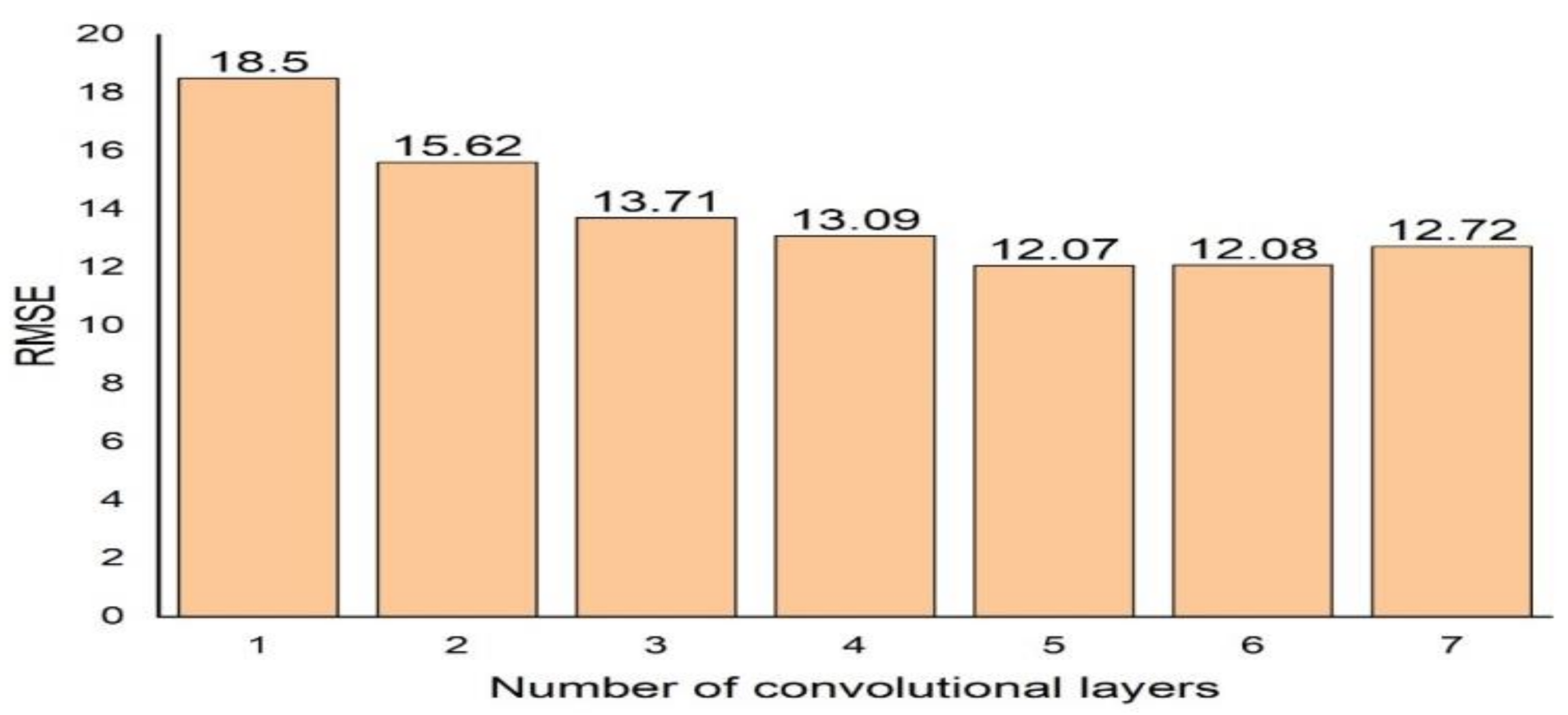


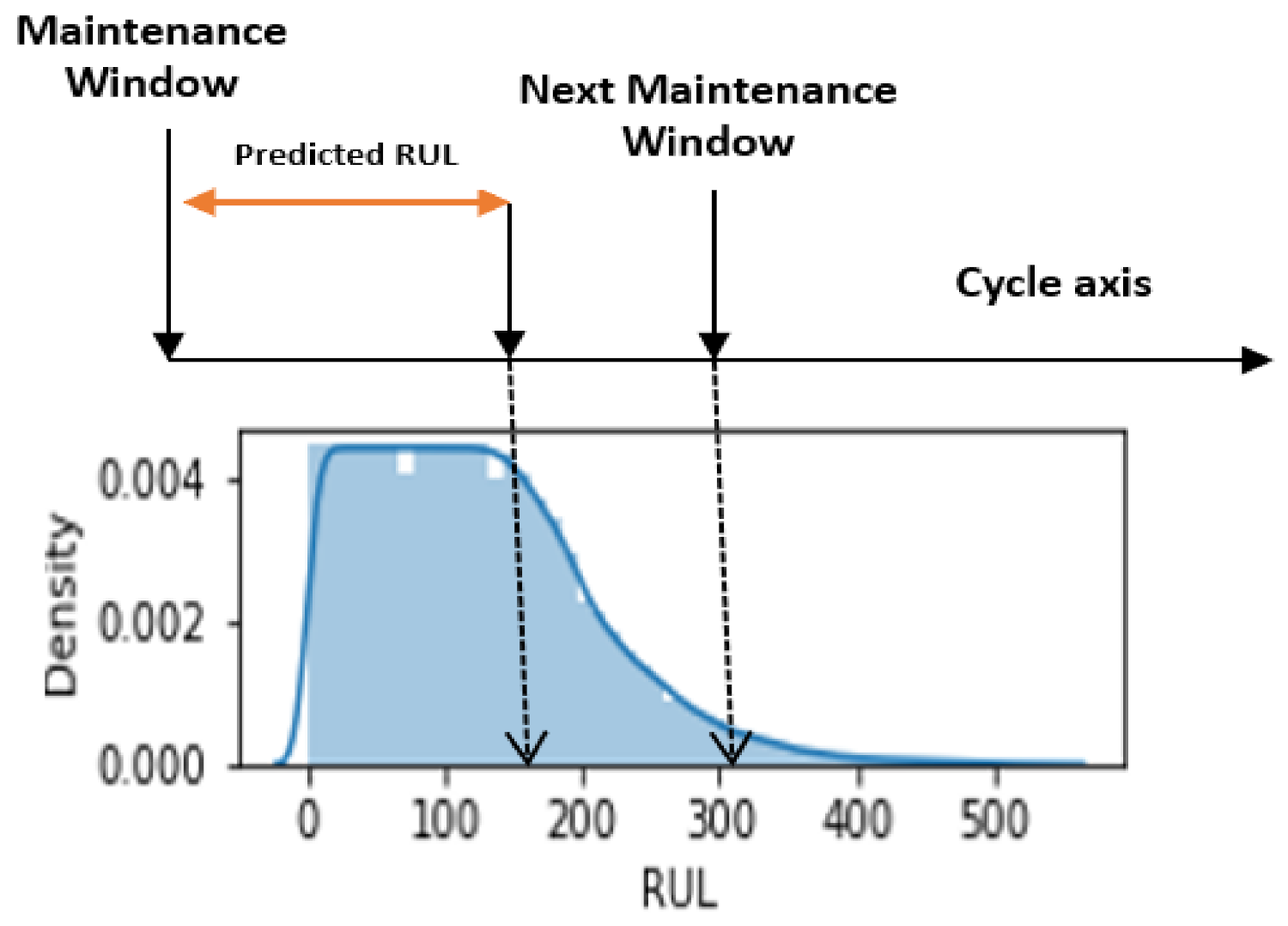
| Authors | Year | Method Used | Benchmark Dataset | Results Achieved | Limitations/Gaps |
|---|---|---|---|---|---|
| Peng et al., [2] | 2021 | FCLCNN-LSTM | C-MAPSS | This model verified only with FD001 (11.17) and FD003 (9.99) subset of data | The key drawback of this model is the need to incrementally update the prognosis results. |
| Wen, Dong and Gao [12] | 2019 | ResCNN | C-MAPSS | RMSE for FD001 (12.16)--- RMSE for FD002 (20.85)--- RMSE for FD003 (12.01)--- RMSE for FD004 (24.79) | The limitations of the proposed method are that the imbalance of signal data is ignored, and the tuning parameter process of the ensemble ResCNN is very time-consuming. |
| Babu et al., [13] | 2016 | First attempt at a deep CNN | C-MAPSS | RMSE for FD001 (18.44)--- RMSE for FD002 (30.29)--- RMSE for FD003 (19.81)--- RMSE for FD004 (29.15) | The limited accuracy of the RUL estimation, means this method is not practical for real-world applications. |
| Li, Ding & Sun, [14] | 2018 | DCNN | C-MAPSS | RMSE for FD001 (18.45)--- RMSE for FD002 (22.36)--- RMSE for FD003 (12.64)--- RMSE for FD004 29.16 | Additional architecture improvements are required, as the current training time exceeds that of the majority of shallow networks in the literature. |
| Zhang et al., [36] | 2016 | Multi-objective deep belief network ensemble | C-MAPSS | RMSE for FD001 (15.04)--- RMSE for FD002 (25.05)--- RMSE for FD003 (12.51)--- RMSE for FD004 (28.66) | This model suffers from slow prediction process and limited accuracy of RUL estimation, which made it not cost-effective method in industrial contexts. |
| Zheng et al., [37] | 2017 | Deep LSTM | C-MAPSS | RMSE for FD001 (16.14)--- RMSE for FD002 (24.49)--- RMSE for FD003 (16.18)--- RMSE for FD004 (28.17) | The main drawback can be summarised in twofold. First, the limited accuracy of the RUL prediction, which make this method is not practical for industrial contexts. Second, high computational load. |
| Zhu, Chen and Peng [38] | 2018 | multi-scale CNN | PRONOSTIA | Tested on bearing dataset | Further architecture improvements are required, as the current model need more optimization. |
| Zhang et al., [39] | 2019 | CNN-XGB | C-MAPSS | RMSE for FD001 (12.61)--- RMSE for FD002 (19.61)--- RMSE for FD003 (13.01)--- RMSE for FD004 (19.41) | This main drawback of this method is the computational speed and cost, with a prediction time of around 621.7 s. It not cost-effective model in industrial contexts. |
| This study | 2021 | Attention-based DCNN | C-MAPSS | RMSE for FD001 (11.81)--- RMSE for FD002 (18.34)--- RMSE for FD003 (13.08)--- RMSE for FD004 (19.88) | The proposed model training time is 142 s, which shows its superiority in reducing the training time and model complexity compared to several popular methods in the literature |
| Dataset | C-MAPSS | |||
|---|---|---|---|---|
| FD001 | FD002 | FD003 | FD004 | |
| Training Units (N) | 100 | 260 | 100 | 249 |
| Testing Units | 100 | 259 | 100 | 248 |
| Operating Conditions (OC) | 1 | 6 | 1 | 6 |
| Fault modes (FM) | 1 | 1 | 2 | 2 |
| Training samples (default) | 17,731 | 48,819 | 21,820 | 57,522 |
| Testing samples | 100 | 259 | 100 | 248 |
| Batch Size | Dropout Size | Epoch Number | Iteration per Epoch | Maximum Alteration | Num Hidden Units | Activation |
|---|---|---|---|---|---|---|
| 512 | 0.5 | 20 | 32 | 640 | 1000 | RELU |
| Pooling Layer | RMSE |
|---|---|
| With | 21.34 |
| Without | 14.92 |
| Prediction Model | C-MAPSS | ||||
|---|---|---|---|---|---|
| Measure | FD001 | FD002 | FD003 | FD004 | |
| Proposed attention-based DCNN Predictor | RMSE--- Score | 11.81--- 223.0 | 18.34--- 2550 | 13.08--- 280.5 | 19.88--- 2982.31 |
| CNN-XGB [39] | RMSE--- Score | 12.61--- 224.73 | 19.61--- 2525.99 | 13.01--- 279.36 | 19.41--- 2930.65 |
| MODBNE [36] | RMSE--- Score | 15.04--- 334.23 | 25.05--- 5585.34 | 12.51--- 6557.62 | 28.66--- 6557.62 |
| Echo State Network with Kalman Filter [55] | RMSE--- Score | 63.46--- - | - --- - | - --- - | - --- - |
| ANN-EN [56] | RMSE--- Score | 14.39--- 337 | 29.09--- - | 15.42--- 533 | 34.74--- - |
| MLP [13] | RMSE--- Score | 37.56--- 17972 | 80.03--- 780280 | 37.56--- 17409 | 77.36--- 5616600 |
| Deep CNN [13] | RMSE--- Score | 18.45--- 1286.7 | 30.29--- 13570 | 19.81--- 1596.2 | 29.16--- 7886.4 |
| DW-RNN [57] | RMSE--- Score | 22.52--- N/A | 25.90--- N/A | 18.75--- N/A | 24.44--- N/A |
| MTL-RNN [57] | RMSE--- Score | 21.47--- N/A | 25.78--- N/A | 17.98--- N/A | 22.82--- N/A |
| DCNN [14] | RMSE--- Score | 12.61--- 273.7 | 22.36--- 10412.0 | 12.64--- 284.1 | 23.31--- 12466 |
Publisher’s Note: MDPI stays neutral with regard to jurisdictional claims in published maps and institutional affiliations. |
© 2021 by the authors. Licensee MDPI, Basel, Switzerland. This article is an open access article distributed under the terms and conditions of the Creative Commons Attribution (CC BY) license (https://creativecommons.org/licenses/by/4.0/).
Share and Cite
Muneer, A.; Taib, S.M.; Fati, S.M.; Alhussian, H. Deep-Learning Based Prognosis Approach for Remaining Useful Life Prediction of Turbofan Engine. Symmetry 2021, 13, 1861. https://doi.org/10.3390/sym13101861
Muneer A, Taib SM, Fati SM, Alhussian H. Deep-Learning Based Prognosis Approach for Remaining Useful Life Prediction of Turbofan Engine. Symmetry. 2021; 13(10):1861. https://doi.org/10.3390/sym13101861
Chicago/Turabian StyleMuneer, Amgad, Shakirah Mohd Taib, Suliman Mohamed Fati, and Hitham Alhussian. 2021. "Deep-Learning Based Prognosis Approach for Remaining Useful Life Prediction of Turbofan Engine" Symmetry 13, no. 10: 1861. https://doi.org/10.3390/sym13101861
APA StyleMuneer, A., Taib, S. M., Fati, S. M., & Alhussian, H. (2021). Deep-Learning Based Prognosis Approach for Remaining Useful Life Prediction of Turbofan Engine. Symmetry, 13(10), 1861. https://doi.org/10.3390/sym13101861








